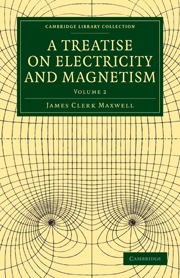Book contents
- Frontmatter
- Contents
- PART III MAGNETISM
- PART IV ELECTROMAGNETISM
- CHAPTER I ELECTROMAGNETIC FORCE
- CHAPTER II MUTUAL ACTION OF ELECTRIC CURRENTS
- CHAPTER III INDUCTION OF ELECTRIC CURRENTS
- CHAPTER IV INDUCTION OF A CURRENT ON ITSELF
- CHAPTER V GENERAL EQUATIONS OF DYNAMICS
- CHAPTER VI APPLICATION OF DYNAMICS TO ELECTROMAGNETISM
- CHAPTER VII ELECTROKINETICS
- CHAPTER VIII EXPLORATION OF THE FIELD BY MEANS OF THE SECONDARY CIRCUIT
- CHAPTER IX GENERAL EQUATIONS
- CHAPTER X DIMENSIONS OF ELECTRIC UNITS
- CHAPTER XI ENERGY AND STRESS
- CHAPTER XII CURRENT-SHEETS
- CHAPTER XIII PARALLEL CURRENTS
- CHAPTER XIV CIRCULAR CURRENTS
- CHAPTER XV ELECTROMAGNETIC INSTRUMENTS
- CHAPTER XVI ELECTROMAGNETIC OBSERVATIONS
- CHAPTER XVII ELECTRICAL MEASUREMENT OF COEFFICIENTS OF INDUCTION
- CHAPTER XVIII DETERMINATION OF RESISTANCE IN ELECTROMAGNETIC MEASURE
- CHAPTER XIX COMPARISON OF ELECTROSTATIC WITH ELECTROMAGNETIC UNITS
- CHAPTER XX ELECTROMAGNETIC THEORY OF LIGHT
- CHAPTER XXI MAGNETIC ACTION ON LIGHT
- CHAPTER XXII ELECTRIC THEORY OF MAGNETISM
- CHAPTER XXIII THEORIES OF ACTION AT A DISTANCE
- INDEX
- Plate section
CHAPTER XV - ELECTROMAGNETIC INSTRUMENTS
Published online by Cambridge University Press: 05 July 2011
- Frontmatter
- Contents
- PART III MAGNETISM
- PART IV ELECTROMAGNETISM
- CHAPTER I ELECTROMAGNETIC FORCE
- CHAPTER II MUTUAL ACTION OF ELECTRIC CURRENTS
- CHAPTER III INDUCTION OF ELECTRIC CURRENTS
- CHAPTER IV INDUCTION OF A CURRENT ON ITSELF
- CHAPTER V GENERAL EQUATIONS OF DYNAMICS
- CHAPTER VI APPLICATION OF DYNAMICS TO ELECTROMAGNETISM
- CHAPTER VII ELECTROKINETICS
- CHAPTER VIII EXPLORATION OF THE FIELD BY MEANS OF THE SECONDARY CIRCUIT
- CHAPTER IX GENERAL EQUATIONS
- CHAPTER X DIMENSIONS OF ELECTRIC UNITS
- CHAPTER XI ENERGY AND STRESS
- CHAPTER XII CURRENT-SHEETS
- CHAPTER XIII PARALLEL CURRENTS
- CHAPTER XIV CIRCULAR CURRENTS
- CHAPTER XV ELECTROMAGNETIC INSTRUMENTS
- CHAPTER XVI ELECTROMAGNETIC OBSERVATIONS
- CHAPTER XVII ELECTRICAL MEASUREMENT OF COEFFICIENTS OF INDUCTION
- CHAPTER XVIII DETERMINATION OF RESISTANCE IN ELECTROMAGNETIC MEASURE
- CHAPTER XIX COMPARISON OF ELECTROSTATIC WITH ELECTROMAGNETIC UNITS
- CHAPTER XX ELECTROMAGNETIC THEORY OF LIGHT
- CHAPTER XXI MAGNETIC ACTION ON LIGHT
- CHAPTER XXII ELECTRIC THEORY OF MAGNETISM
- CHAPTER XXIII THEORIES OF ACTION AT A DISTANCE
- INDEX
- Plate section
Summary
Galvanometers.
707.] A Galvanometer is an instrument by means of which an electric current is indicated or measured by its magnetic action.
When the instrument is intended to indicate the existence of a feeble current, it is called a Sensitive Galvanometer.
When it is intended to measure a current with the greatest accuracy in terms of standard units, it is called a Standard Galvanometer.
All galvanometers are founded on the principle of Schweigger's Multiplier, in which the current is made to pass through a wire, which is coiled so as to pass many times round an open space, within which a magnet is suspended, so as to produce within this space an electromagnetic force, the intensity of which is indicated by the magnet.
In sensitive galvanometers the coil is so arranged that its windings occupy the positions in which their influence on the magnet is greatest. They are therefore packed closely together in order to be near the magnet.
Standard galvanometers are constructed so that the dimensions and relative positions of all their fixed parts may be accurately known, and that any small uncertainty about the position of the moveable parts may introduce the smallest possible error into the calculations.
In constructing a sensitive galvanometer we aim at making the field of electromagnetic force in which the magnet is suspended as intense as possible.
- Type
- Chapter
- Information
- A Treatise on Electricity and Magnetism , pp. 313 - 334Publisher: Cambridge University PressPrint publication year: 2010First published in: 1873



